Page 372 of 393
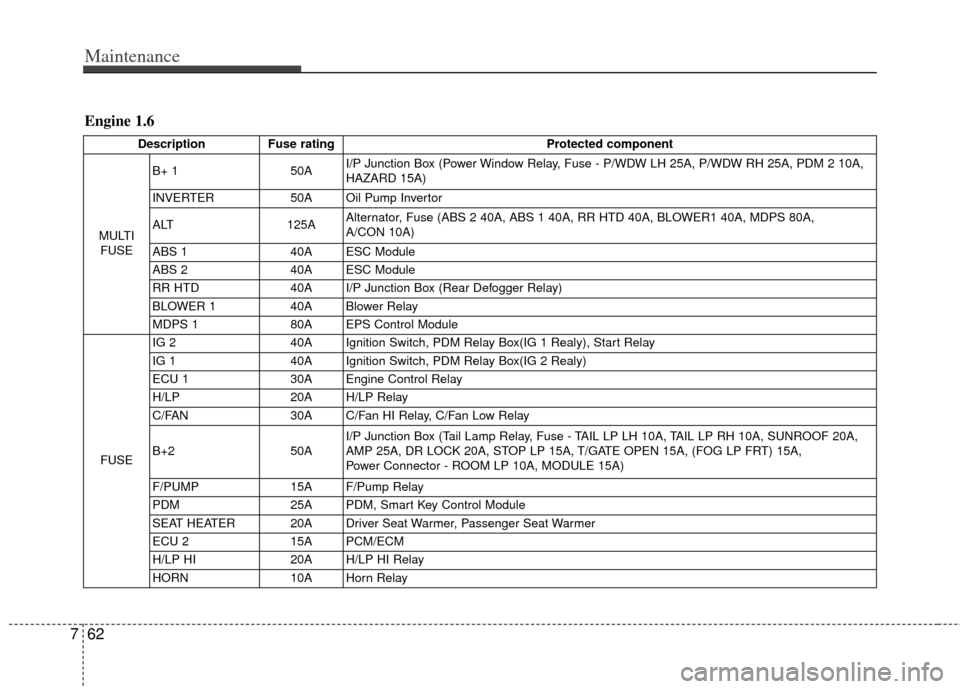
Maintenance
62
7
Engine 1.6
Description Fuse rating Protected component
MULTI FUSE B+ 1
50AI/P Junction Box (Power Window Relay, Fuse - P/WDW LH 25A, P/WDW RH 25A, PDM 2 10A,
HAZARD 15A)
INVERTER 50A Oil Pump Invertor
ALT 125AAlternator, Fuse (ABS 2 40A, ABS 1 40A, RR HTD 40A, BLOWER1 40A, MDPS 80A,
A/CON 10A)
ABS 1 40A ESC Module
ABS 2 40A ESC Module
RR HTD 40A I/P Junction Box (Rear Defogger Relay)
BLOWER 1 40A Blower Relay
MDPS 1 80A EPS Control Module
FUSE IG 2
40A Ignition Switch, PDM Relay Box(IG 1 Realy), Start Relay
IG 1 40A Ignition Switch, PDM Relay Box(IG 2 Realy)
ECU 1 30A Engine Control Relay
H/LP 20A H/LP Relay
C/FAN 30A C/Fan HI Relay, C/Fan Low Relay
B+2 50AI/P Junction Box (Tail Lamp Relay, Fuse - TAIL LP LH 10A, TAIL LP RH 10A, SUNROOF 20A,
AMP 25A, DR LOCK 20A, STOP LP 15A, T/GATE OPEN 15A, (FOG LP FRT) 15A,
Power Connector - ROOM LP 10A, MODULE 15A)
F/PUMP 15A F/Pump Relay
PDM 25A PDM, Smart Key Control Module
SEAT HEATER 20A Driver Seat Warmer, Passenger Seat Warmer
ECU 2 15A PCM/ECM
H/LP HI 20A H/LP HI Relay
HORN 10A Horn Relay
Page 374 of 393
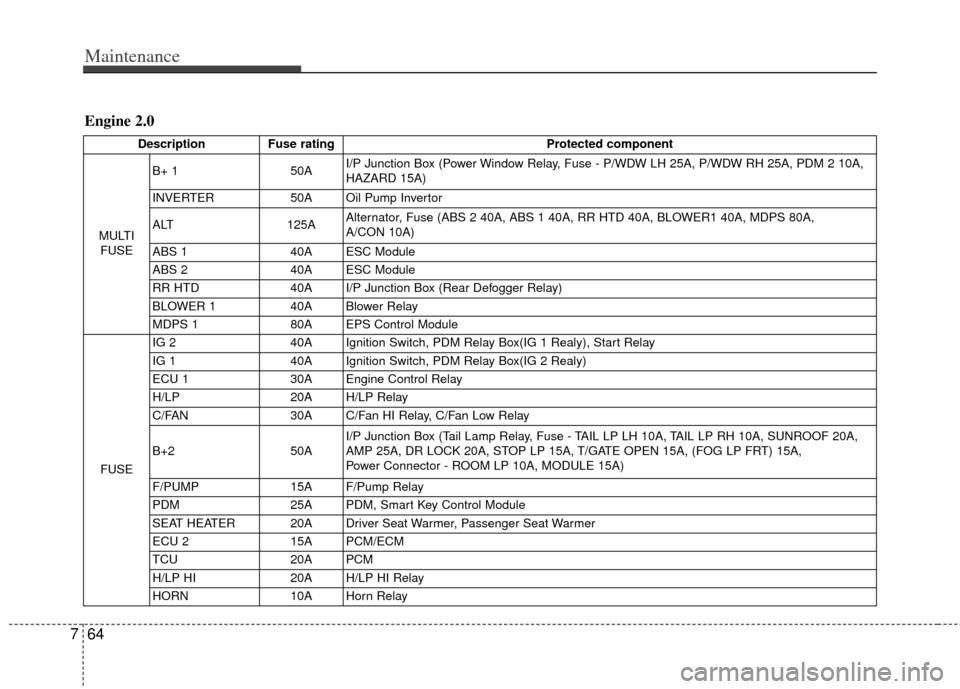
Maintenance
64
7
Engine 2.0
Description Fuse rating Protected component
MULTI FUSE B+ 1
50AI/P Junction Box (Power Window Relay, Fuse - P/WDW LH 25A, P/WDW RH 25A, PDM 2 10A,
HAZARD 15A)
INVERTER 50A Oil Pump Invertor
ALT 125AAlternator, Fuse (ABS 2 40A, ABS 1 40A, RR HTD 40A, BLOWER1 40A, MDPS 80A,
A/CON 10A)
ABS 1 40A ESC Module
ABS 2 40A ESC Module
RR HTD 40A I/P Junction Box (Rear Defogger Relay)
BLOWER 1 40A Blower Relay
MDPS 1 80A EPS Control Module
FUSE IG 2
40A Ignition Switch, PDM Relay Box(IG 1 Realy), Start Relay
IG 1 40A Ignition Switch, PDM Relay Box(IG 2 Realy)
ECU 1 30A Engine Control Relay
H/LP 20A H/LP Relay
C/FAN 30A C/Fan HI Relay, C/Fan Low Relay
B+2 50AI/P Junction Box (Tail Lamp Relay, Fuse - TAIL LP LH 10A, TAIL LP RH 10A, SUNROOF 20A,
AMP 25A, DR LOCK 20A, STOP LP 15A, T/GATE OPEN 15A, (FOG LP FRT) 15A,
Power Connector - ROOM LP 10A, MODULE 15A)
F/PUMP 15A F/Pump Relay
PDM 25A PDM, Smart Key Control Module
SEAT HEATER 20A Driver Seat Warmer, Passenger Seat Warmer
ECU 2 15A PCM/ECM
TCU 20A PCM
H/LP HI 20A H/LP HI Relay
HORN 10A Horn Relay
Page 377 of 393
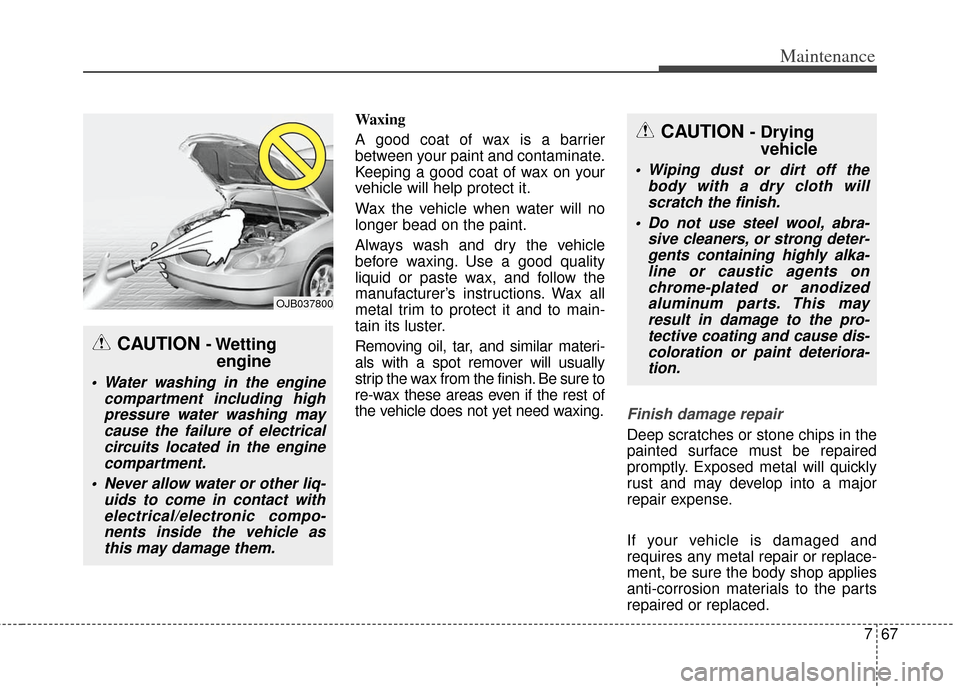
767
Maintenance
Waxing
A good coat of wax is a barrier
between your paint and contaminate.
Keeping a good coat of wax on your
vehicle will help protect it.
Wax the vehicle when water will no
longer bead on the paint.
Always wash and dry the vehicle
before waxing. Use a good quality
liquid or paste wax, and follow the
manufacturer’s instructions. Wax all
metal trim to protect it and to main-
tain its luster.
Removing oil, tar, and similar materi-
als with a spot remover will usually
strip the wax from the finish. Be sure to
re-wax these areas even if the rest of
the vehicle does not yet need waxing.
Finish damage repair
Deep scratches or stone chips in the
painted surface must be repaired
promptly. Exposed metal will quickly
rust and may develop into a major
repair expense.
If your vehicle is damaged and
requires any metal repair or replace-
ment, be sure the body shop applies
anti-corrosion materials to the parts
repaired or replaced.
OJB037800
CAUTION - Wettingengine
Water washing in the engine
compartment including highpressure water washing maycause the failure of electricalcircuits located in the enginecompartment.
Never allow water or other liq- uids to come in contact withelectrical/electronic compo-nents inside the vehicle asthis may damage them.
CAUTION - Drying vehicle
Wiping dust or dirt off the
body with a dry cloth willscratch the finish.
Do not use steel wool, abra- sive cleaners, or strong deter-gents containing highly alka-line or caustic agents onchrome-plated or anodizedaluminum parts. This mayresult in damage to the pro-tective coating and cause dis-coloration or paint deteriora-tion.
Page 389 of 393
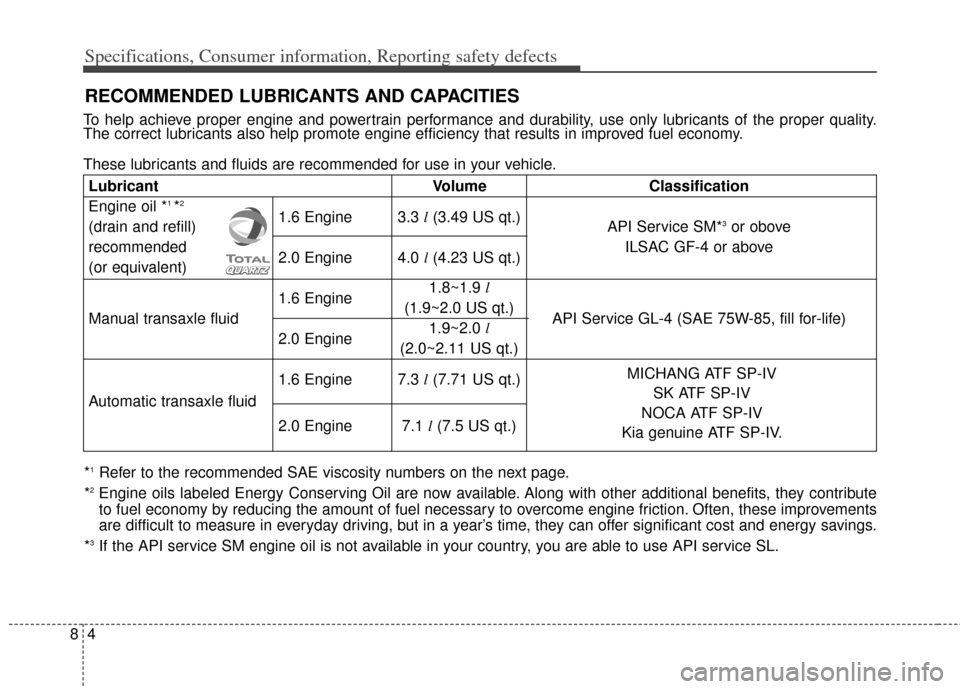
Specifications, Consumer information, Reporting safety defects
48
RECOMMENDED LUBRICANTS AND CAPACITIES
To help achieve proper engine and powertrain performance and durability, use only lubricants of the proper quality.
The correct lubricants also help promote engine efficiency that results in improved fuel economy.
These lubricants and fluids are recommended for use in your vehicle.
*1Refer to the recommended SAE viscosity numbers on the next page.
*2Engine oils labeled Energy Conserving Oil are now available. Along with other additional benefits, they contribute
to fuel economy by reducing the amount of fuel necessary to overcome engine friction. Often, these improvements
are difficult to measure in everyday driving, but in a year’s time, they can offer significant cost and energy savings.
*
3If the API service SM engine oil is not available in your country, you are able to use API service SL.
Lubricant Volume Classification
Engine oil *1 *2
1.6 Engine 3.3 l (3.49 US qt.)
(drain and refill) API Service SM*3or obove
recommended 2.0 Engine 4.0 l(4.23 US qt.) ILSAC GF-4 or above
(or equivalent)
1.6 Engine1.8~1.9
l
Manual transaxle fluid (1.9~2.0 US qt.)
API Service GL-4 (SAE 75W-85, fill for-life)
2.0 Engine 1.9~2.0
l
(2.0~2.11 US qt.)
1.6 Engine 7.3 l (7.71 US qt.)
Automatic transaxle fluid
2.0 Engine 7.1 l(7.5 US qt.)
MICHANG ATF SP-IV
SK ATF SP-IV
NOCA ATF SP-IV
Kia genuine ATF SP-IV.
Page 391 of 393
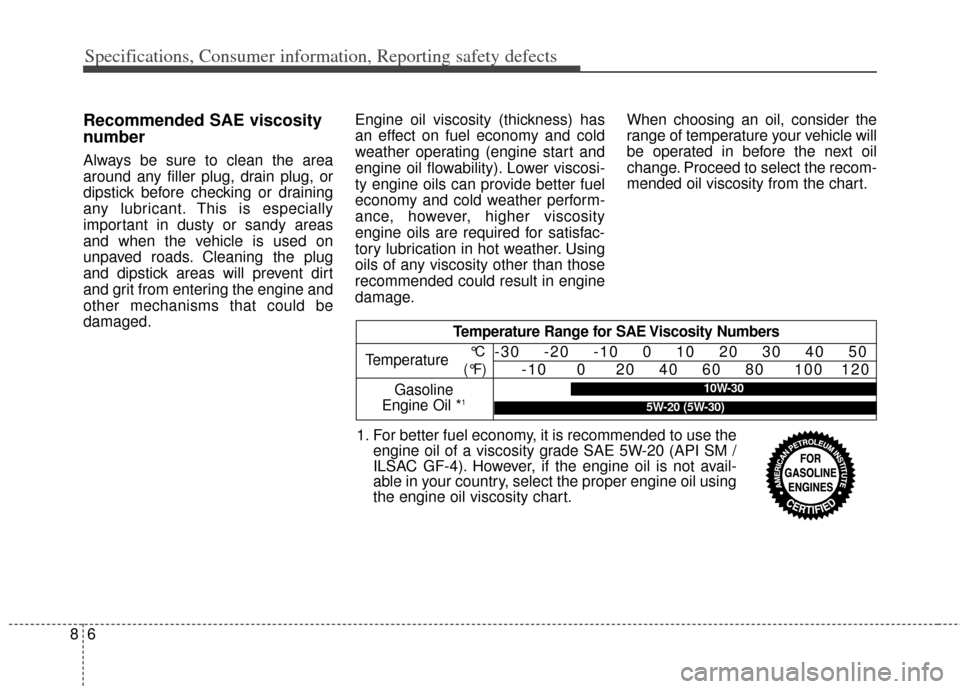
Specifications, Consumer information, Reporting safety defects
68
Recommended SAE viscosity
number
Always be sure to clean the area
around any filler plug, drain plug, or
dipstick before checking or draining
any lubricant. This is especially
important in dusty or sandy areas
and when the vehicle is used on
unpaved roads. Cleaning the plug
and dipstick areas will prevent dirt
and grit from entering the engine and
other mechanisms that could be
damaged.Engine oil viscosity (thickness) has
an effect on fuel economy and cold
weather operating (engine start and
engine oil flowability). Lower viscosi-
ty engine oils can provide better fuel
economy and cold weather perform-
ance, however, higher viscosity
engine oils are required for satisfac-
tory lubrication in hot weather. Using
oils of any viscosity other than those
recommended could result in engine
damage.
When choosing an oil, consider the
range of temperature your vehicle will
be operated in before the next oil
change. Proceed to select the recom-
mended oil viscosity from the chart.
Temperature Range for SAE Viscosity Numbers
Temperature
Gasoline
Engine Oil *
1
°C
(°F)-30 -20 -10 0 10 20 30 40 50 -10 0 20 40 60 80 100 120
1. For better fuel economy, it is recommended to use theengine oil of a viscosity grade SAE 5W-20 (API SM /
ILSAC GF-4). However, if the engine oil is not avail-
able in your country, select the proper engine oil using
the engine oil viscosity chart.
10W-30
5W-20 (5W-30)